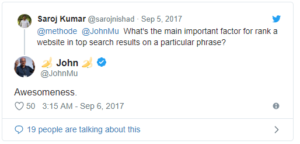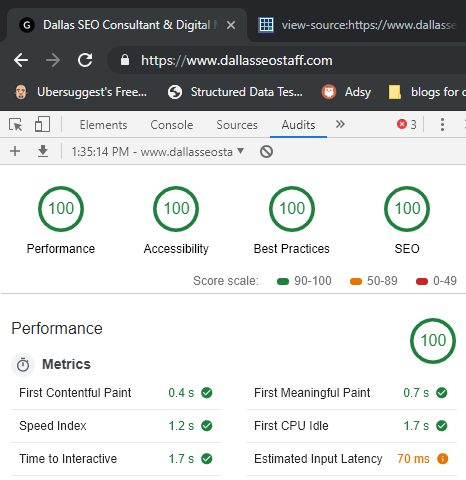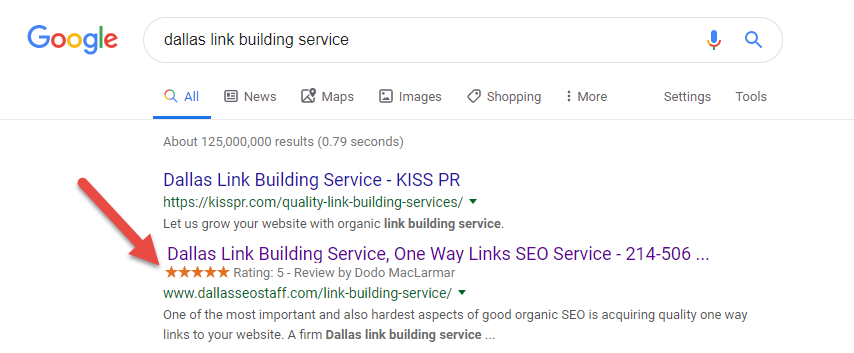There are more than 200 signals Google uses to rank any given page on a website. Every year they seem to focus SEO on something new (without forgetting about the others):
- SSL / https:// became a rankign signal in 2014
- mobile usability (mobile first indexing) became important in 2015
- 2017 pushed even harder on SSL
- Mobile page load speed became very important last year
These make sense – more people are using their phones and tablets on 3/4/5g networks to browse rather than desktops on WiFi. There’s an increasing emphasis on security since more and more sites (and their user information) is getting hacked.
So what’s next and what’s still important in SEO?
To sum it all up, John Mueller from Google said the key to top Google rankings is “awesomness”.

Knowing that, it makes sense to make your site awesome for your users. That means informative, interesting content and good user experience (easy to navigate, ADA compliant, plenty of images and videos that support content, etc). In the end Google wants to serve up sites that not only address their searchers query but provide a good experience.
So what are the top ranking factors?
As mentioned above there are more than 200 SEO ranking signals that puts one site above another for any given search. Although each one is important, there are a handful that get you more bang for your buck:
1. High Quality, Unique Content
You’ve probably heard it before: Content is King! Of course it is. If you don’t have useful content (text, video, images, etc) on your site no one will be interested in your site. Google and SEO authorities all say optimized content is one of the top ranking factors today and probably will always be. Here are a few things to consider when publishing content on your site:
-
- Length: 300 words is the minimum you should write (I say 500+)
- Keywords – What are you trying to rank for?
- Keyword Density: Make sure computers can understand what your page is about. This includes synonyms (lawyer/attorney/law firm, shoe/sneakers/kiks)
- Readability – Flesch Reading Ease Score
- Consider Search Intent – Example: Are you writing about Blue jays the bird or Blue Jays the baseball team?
- Voice Search – More people are asking their phone questions that need to be answered. Google “QA Markup”
2. Page load time
The faster your site loads the more likely a user will stick around and the more likely they are to buy your product or service. There are several tools that will analyze your page load speed and give recommendations on what needs to be fixed. The Lighthouse plugin for Chrome is my favorite. It analyzes several factors including page load speed. For desktop and mobile versions of your site. Here’s a screenshot of our results…

3. Mobile Friendly
More and more people are abandoning desktop computers for their phones or tablets. If your site doesn’t look good on a smaller screen you’ll lose visitors quickly. Even older sites can adopt a responsive design with some simple CSS updates. That means the same exact page and content appears differently based on the size of the users screen. Typically content, images, etc is stacked on a phone rather than side by side. I also include mobile load speed in this category. People are becoming more and more impatient and if your site loads slowly they will move on to your competitors. Recently Google implemented “Mobile first indexing” which means all search results, even if you’rs searching form a desktop, will be based on the mobile friendliness of your site.
4. Security / SSL / HTTPS
for the last five years Google has given a boost to sites that are secure and use SSL / https://. You’ve probably read about the several data breaches of major companies over the years. Although your site may not save sensitive information an unsecured site is vulnerable to hackers who can add dangerous code that can compromise your end users. Adding SSl to your site is cheap if not free so there’s no reason not to do it.
Note – Adding SSL may hurt your SEO if you end up having duplicate pages (both http and https versions) listed in Google.
5. User Experience
UX is not only about how pretty your site is but how intuitive it is and easy to use. This includes users who can not see or hear well or at all. Although Google can’t analyze your site’s appearance or usability it does glean information from user behavior metrics. This includes time on site, hoe many pages a user reads, bounce rate, etc. And also site load speed as mentioned above.
A good site hierarchy is essential to help users find what they’re looking for and understand how to get from page A to page B. A solid hierarchy also helps search engines better understand your site.
6. Internal Linking
In short, internal linking with proper anchor text will help Google understand your pages even further. For example a link to our home page with anchor text Dallas SEO Consultant will help Google understand the overall topic of our site is that we are SEO consultants in Dallas.
7. Meta Data
An oldie but a goodie – Meta data is the information that may not be visible on your pages but tell Google what your page is about and typically appears in the SERPS (Search Results). This includes the Page title tag, descriptions, structured data markup and a few other coding updates. Meta data tells Google specifics about your site, page, elements on the page. Things like video run time, logo url, site owner, and hundreds of other facts you may not need to tell users on every page.
8. Schema Markup
Considered part of Meta Data in my opinion, this deserves its own paragraph. Schema markup is critical for describing your products, services, organization and hundreds of other parts of your business and website. Proper schema markup can even affect the appearance of your search results. It can add 5 gold stars in the results or display an image or video.

